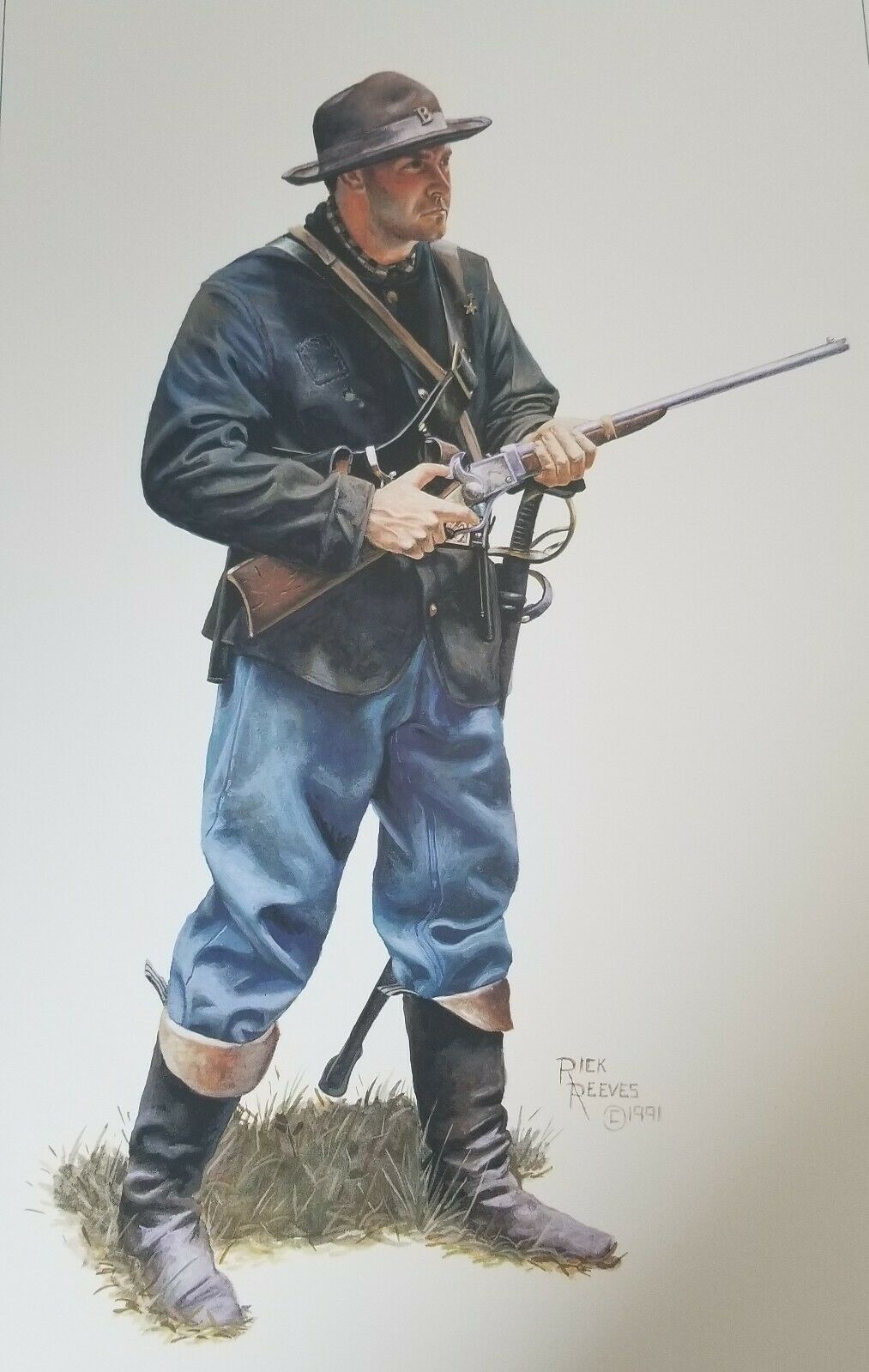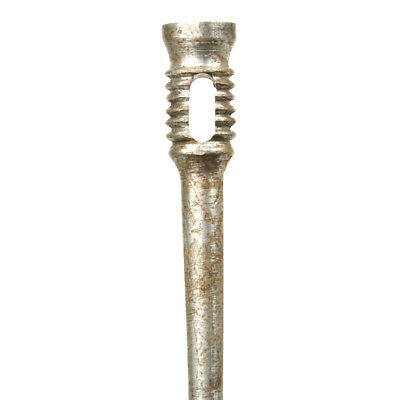-40%
FEDERAL CAVALRYMAN by Rick Reeves Civil War Limited edition Art print
$ 23.76
- Description
- Size Guide
Description
FEDERAL CAVALRYMAN - ARMY OF YTHE CUMBERLAND by Rick REEVES. Measures 17.5" x 11" and limited to only 550 signed and numbered PRINTS in the edition. Published in early 1991 and long ago SOLD OUT!!!!! Includes certificate of authenticity. Mint condition, never framed. No defects. Number will be different than the one shown. Insured Priority mail delivery in the continental US is $ 15.00. Will ship Worldwide and will combine shipping when practical.Will be shipped in a extra heavy duty tube that has to be purchased and not the cheap post office type that crushes easily. That is why the high (as some have complained) shipping cost.
Rick Reeves was born in Tampa, FL in 1959. He began taking art lessons at an early age, from a local artist, in the traditional academic way of the 19th century. This was something not taught in most of the colleges in the 1970’s which focused on abstract and the “everything is art” mentality. However, it was the Brandywine school of Howard Pyle that led Rick into the arts as a career. The Brandywine school was a style of illustration founded by Pyle at the end of the 19th century. The works produced there were widely published in adventure novels, magazines, and romances in the early 20th century.
Rick graduated with a degree in Studio Art from Florida State University in Tallahassee, FL. He also studied at Southampton College in Long Island, NY and the University of South Florida in Tampa, FL. Upon graduation he worked for a short time at an advertising agency before striking out on his own as a Freelance Illustrator. He then turned his focus to fine art that brought about his interest in historical subject matter. In 1988 Rick started his own publishing company, Collector Historical Prints, Inc. Rick then published under Paramount Press of Jamestown, NY, American Art and Antiques of Virginia and American Historical Art of Ft. Leavenworth, KS.
Rick’s art, prints and posters hang proudly in the U.S. Army War College, the U.S. Army Command and General Staff College, the National Guard Bureau, the Cavalry Museum, the 12th Armored Division Memorial Museum, the 2-505 Parachute Infantry Regimental Headquarters, the 307th Engineer Battalion, 25th Infantry (L) Division Headquarters, the Atlanta Cyclorama, the Florida Sports Hall of Fame and countless public and private collections throughout the country.
The Army of the Cumberland was one of the principal Union armies in the Western Theater during the American Civil War. It was originally known as the Army of the Ohio.
Maj. Gen. William S. Rosecrans
The origin of the Army of the Cumberland dates back to the creation of the Army of the Ohio in November 1861, under the command of Brig. Gen. Robert Anderson. The army fought under the name Army of the Ohio until Maj. Gen. William S. Rosecrans assumed command of the army and the Department of the Cumberland and changed the name of the combined entity to the Army of the Cumberland. When Rosecrans assumed command, the army and the XIV Corps were the same unit, divided into three "grand divisions" (wings) commanded by Alexander McCook (Right Wing), George H. Thomas (Center), and Thomas L. Crittenden (Left).
General Orders No. 168 was the order passed by the Union Army on October 24, 1862, that called for the commissioning the XIV Corps into the Army of the Cumberland.
The army's first significant combat under the Cumberland name was at the Battle of Stones River. After the battle the army and XIV Corps were separated. The former Center wing became XIV Corps, the Right wing became XX Corps, and the Left wing became XXI Corps. Rosecrans still retained command of the army. He next led it through the Tullahoma Campaign and at the Battle of Chickamauga, after which the army became besieged at Chattanooga. Maj. Gen. Ulysses S. Grant arrived at Chattanooga. Reinforcements from the Army of the Potomac and the Army of the Tennessee also arrived. Rosecrans had been a popular and respected commander, but because of his defeat at Chickamauga and inability to lift the Confederate siege, Grant chose to replace him with George H. Thomas on October 19, 1863.
Maj. Gen. George H. Thomas
In the Battles for Chattanooga, Grant had been leery of using the Army of the Cumberland in the main fighting, fearing their morale to be too low after the defeat at Chickamauga. Instead, he used the veterans from the Army of the Potomac, proud of their recent victory at the Battle of Gettysburg, to take Lookout Mountain and planned to use the troops from the Army of the Tennessee, also recent victors at the Siege of Vicksburg, to attack the Confederate right flank on Missionary Ridge. The Army of the Cumberland was given the minor task of seizing the rifle pits at the base of Missionary Ridge. However, once they achieved their objective, four divisions (one led by Philip H. Sheridan) stormed up the ridge and routed the Confederate center. When Grant angrily asked who had ordered those troops up the ridge both Thomas and Gordon Granger, a corps commander in the army, responded they did not know. Granger then added, "Once those boys get started, all hell can't stop 'em."
After Grant's victory at Chattanooga earned him promotion to general-in-chief of the U.S. Army, Maj. Gen. William T. Sherman assumed command of Grant's Military Division of the Mississippi, which controlled all Union armies in the West. He created an "army group" of the Army of the Cumberland, the Army of the Tennessee, and the Army of the Ohio and marched towards Atlanta in May 1864. On the way to Atlanta they fought in many battles and skirmishes including the Battle of Kennesaw Mountain. In September, Atlanta fell to Sherman's army group. When Confederate general John B. Hood moved north from Atlanta, Sherman chose not to follow him and instead dispatched some of the Army of the Cumberland (IV Corps and Provisional Detachment) and the Army of the Ohio (XXIII Corps) after him. Thomas finally met Hood at the Battle of Nashville and crushed him, thus bringing to an end any significant military actions for the Army of the Cumberland. Other elements of the Army of the Cumberland (the XIV and XX Corps) marched to the sea and north through the Carolinas with Sherman, under the command of Maj. Gen. Henry W. Slocum. These forces became the Union's Army of Georgia and participated in the Grand Review of the Armies in Washington, D.C., before President Andrew Johnson in 1865.
Command history
Commander
From
To
Major Battles and Campaigns
Major General William S. Rosecrans
October 24, 1862
October 19, 1863
Stones River, Tullahoma Campaign, Chickamauga
Major General George H. Thomas
October 19, 1863
August 1, 1865
Chattanooga, Atlanta Campaign, Franklin, Nashville












